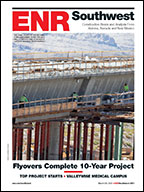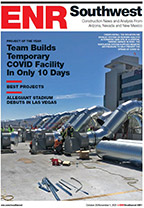Prices for materials used in construction and for nonresidential building construction both increased more than overall prices for “final demand” in January, according to a new analysis of retooled federal data on producer prices released by the Associated General Contractors of America. As a result, margins remain very tight for most construction firms even as private-sector demand for construction continues to grow.
“Although contractors on average were able to raise bid prices in line with materials cost increases, the results varied widely by commodity, building type and specialty trade,” said Ken Simonson, the association’s chief economist. “Several key construction materials, or ‘processed goods,’ experienced substantial price increases that in many cases exceeded what contractors could pass on last month. It will take a few more months to see if these costs increases are sustained—putting a squeeze on contractors’ margins—or a one-time blip.”
Simonson said the overall producer price index for inputs to construction rose 0.6% in January, propelled by a one-month jump of 7.4% in the index for gypsum products; followed by lumber and plywood, 2.4%; cement, 2.0%; insulation materials, 1.5%; and copper and steel products, 1.2% each. He noted that the impact of these price hikes would have been worse if not for declines in the price indexes for diesel fuel of 1.9%; flat glass, -0.6%; and architectural coatings such as paint, -0.3%.
A new set of “final demand” indexes breaks out how much private and public owners are paying for the differing mix of nonresidential buildings they buy, Simonson pointed out. In January, the index for “construction for private capital investment” climbed 0.6% while the index for “construction government” rose 0.8%. The combined index for final demand for construction rose 0.6%, more than the goods and services components of overall final demand, which increased 0.4%.
The price increases varied by building and subcontractor type, the economist said. The index for new school building construction rose the most, 1.0%; followed by office construction, 0.6%; industrial buildings, 0.5%; health care buildings, 0.4%; and warehouses, 0.3%. The index for new, repair and maintenance work on nonresidential buildings by plumbing contractors climbed 1.1% in January; the index for roofing contractors rose 0.7%; and the index for concrete contractors increased 0.4%. In contrast, the index for electrical contractors was unchanged.
Association officials said the fact margins remain tight signals that demand has yet to outstrip contractors’ capacity to perform work in most parts of the country. They added that many firms report competition remains fierce for many projects and that it will take more sustained growth in demand before firms are able to significantly increase what they charge.
Other industry economists weighed in on the price increases as well.
“After a period of unusual stability, materials prices expanded more briskly in January,” said Associated Builders and Contractors Chief Economist Anirban Basu. “While the year-over-year increase in nonresidential construction prices is benign, January raises the question of whether that period of stability is coming to an end.
“While economists work to determine if short-term atmospheric phenomenon or longer-term economic factors were the driving factors behind the volatility, it appears that weather played a dominate role in shaping price patterns in January,” Basu said. “Although it is true that the global economy has been accelerating recently and the nonresidential construction sector is becoming more active in the United States, increased demand for materials likely played a relatively minor role in January's price behavior.”
“Another factor behind January’s aggregate price increase could be the impact of the weather on energy—natural gas prices surged in January and crude energy rose more than 1% during the last month,” Basu said.
Overall, the nation's wholesale goods prices expanded 0.4% in January and are up 0.9% year over year.
The following materials prices increased in January.
• Natural gas prices expanded 14.5% in January and are 27.7% higher than one year ago.



Post a comment to this article
Report Abusive Comment